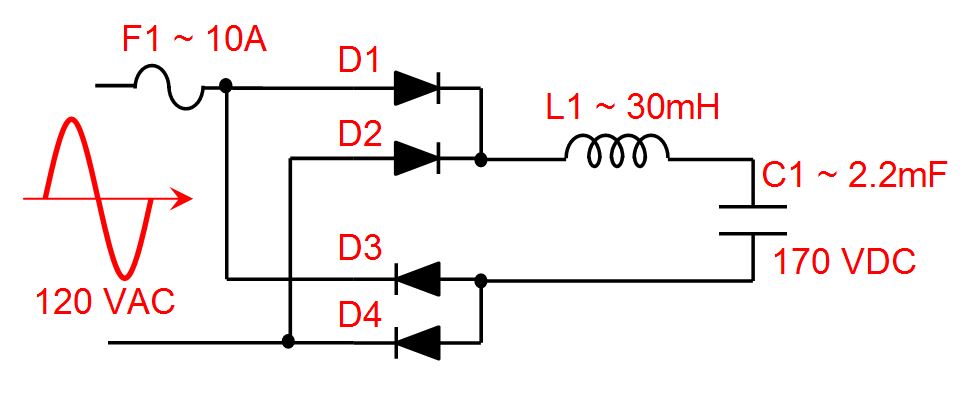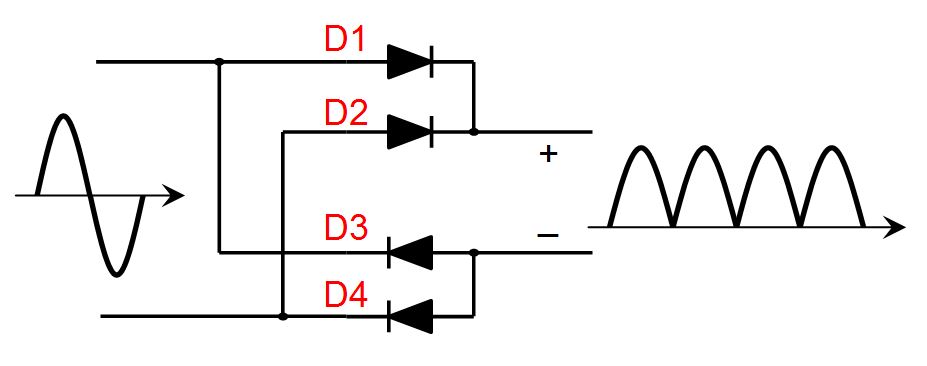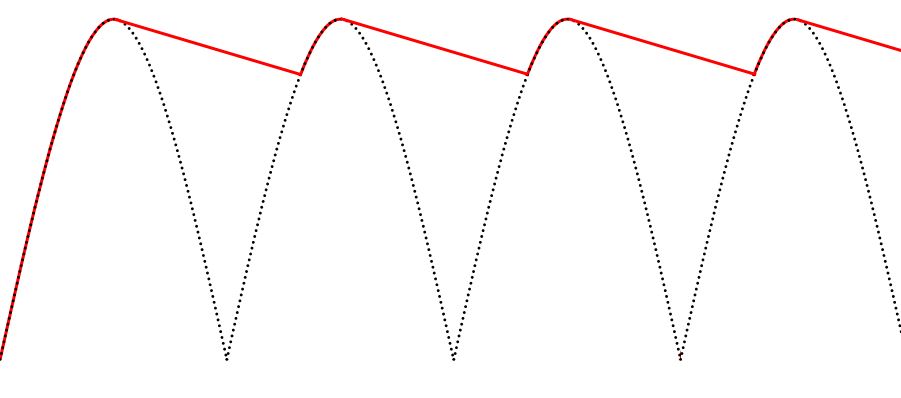A full bridge rectifier is a must have circuit in AC to DC converter circuits.
It is made of 4 diodes. As I mentioned in the video, a diode is an electrical component that only allows the current in one direction to flow, and blocks it from going backwards.
A diode is a semiconductor component made of a N and a P semiconductors fused together.
Following is the diode bridge rectifier circuit. When the voltage across the input is positive the current flows into D1 into the load that is connected between +/- output lines, and returns through D4 to the source. D2 and D3 will be off as they will be reverse biased.
When the input is negative though the current flows through D2 into the circuit, and returns from D3 to the negative supply. D1 and D4 will be off now.
So this circuit ensures the positive output is always positive and the load circuits are protected against reverse polarity. The output would look like a sine wave with negative peaks folded back up to positive as shown in the picture below.
Now to convert those bumps into DC we just add a large capacitor to the output. Picture below shows the bridge I made with component values.
 Let’s ignore the inductor for now. The capacitor charges all the way to the peak of the wave.
Let’s ignore the inductor for now. The capacitor charges all the way to the peak of the wave.
Now imagine it was the positive half of the cycle and and D1 and D4 were on. The capacitor charges to the peak, but as the input starts dropping, in order for the output to go down, the supply must suck the charges away from the capacitor, which means the current flow needs to reverse. But the diodes only conduct in one way and so D1 and D4 both turn off. This results in the output voltage to remain high at the peak.
If there is a load at the output, during the period when all diodes are off and capacitor is holding the voltage, the load will start discharging the capacitor and so the output voltage drops, until the input catches up to the output and starts charging the capacitor again. This is shown in the picture below.
The larger the load, the bigger the ripples. This means the capacitor charges and discharges with large currents. This could hurt the capacitor in long run. And this is why I added a large inductor in series to the output capacitor.
Unlike a capacitor which tries to keep voltage steady but can supply crazy currents, an inductor tries to keep the current steady but can have crazy voltages. So as the capacitor charges to the peak, the load current runs through the inductor and charges it. when the input falls below output, now the inductor discharges its current into the load helping the capacitor to provide current to the load. The diodes won’t turn off now as the inductor pushes and pulls current through them.
So now the capacitor gets to hold the output voltage much more steady with the help of the inductor supplying current when needed. There will be much smaller ripple current through the capacitor and it can survive for much longer time. Now instead of output being ripply, the DC level will drop to a lower level as the load increases.
The inductor also prevents the capacitor to charge with very large currents.
Of course, a single diode can also do a similar thing, but there is a great benefit to bridge rectifier, and that is two peaks charging a capacitor compared to one for single diode. It means much smaller ripple on the same capacitor as it discharges less before the next peak hits. Or the capacitance can get smaller which will save in size of components.
All wall adapters I know have a bridge rectifier. The old school ones had a step down transformer, and the a bridge rectifier to make a DC and sometime a regulator for a solid output voltage.
But new switching supplies which are much more efficient, do the rectification right at the high voltage and then step the DC down which switching DC/DC conversion at very high efficiency. Here are some of their benefits:
- As the rectification is done at high voltage, diode drop is an insignificant voltage relative to high voltage and generates very little inefficiency.
- The current drawn from high voltage is a small fraction of output current due to power conversion and so the bridge and input components can be low power and small.
- The switching circuit switches the voltage at much higher frequencies of 100kHz and above and so the step down transformer size is significantly smaller.
Safety Tips
- Dealing with high voltage is always dangerous, less dangerous when it is DC of course. AC is much more dangerous as more current runs through body due to body’s capacitive property.
- Circuit fusing is very important. Proper rating can save the circuit and prevent fire.
- Like I showed in the video, the scope probe ground is shorted to power cord’s earth. So if you are not careful where you connect your ground, it will short that node to earth. In my case I blew my fuse. So in many cases you need isolation between your scope input lines and where you probe. It can be done by simply applying an insulating tape around the earth pin on power cord. The live and neutral wires are already isolated as they pass through a transformer inside the scope. Sometimes I just break that pin off!
- Having a resistor on a high voltage can generate huge power dissipation. Power = V^2 / R = R x I^2.
- When your bridge rectifier is not connected to a load, the output capacitors can hold the 170VDC for a very long period of time and shock you if you touch them. I showed you how I can’t feel them when I touch 170VDC with my fingers, but it shocked me when they touched the skin on the palm of my hand. It is because skin in different areas have different resistance and you feel the same voltage differently. So be careful around high voltages.


